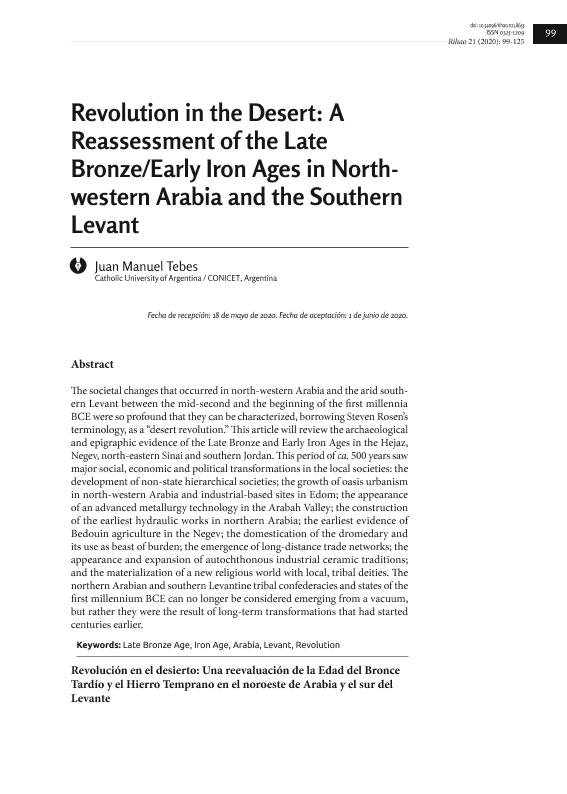Mostrar el registro sencillo del ítem
dc.contributor.author
Tebes, Juan Manuel

dc.date.available
2022-10-03T12:54:13Z
dc.date.issued
2020-10
dc.identifier.citation
Tebes, Juan Manuel; Revolution in the desert: A reassessment of the Late Bronze/Early Iron Ages in northwestern Arabia and the southern Levant; Universidad de Buenos Aires. Facultad de Filosofía y Letras. Instituto de Historia Antigua Oriental; Revista del Instituto de Historia Antigua Oriental; 21; 10-2020; 99-125
dc.identifier.issn
0325-1209
dc.identifier.uri
http://hdl.handle.net/11336/171434
dc.description.abstract
The societal changes that occurred in north-western Arabia and the arid southern Levant between the mid-second and the beginning of the first millennia BCE were so profound that they can be characterized, borrowing Steven Rosen´s terminology, as a "desert revolution." This article will review the archaeological and epigraphic evidence of the Late Bronze and Early Iron Ages in the Hejaz, Negev, north-eastern Sinai and southern Jordan. This period of ca. 500 years saw major social, economic and political transformations in the local societies: the development of non-state hierarchical societies; the growth of oasis urbanism in north-western Arabia and industrial-based sites in Edom; the appearance of an advanced metallurgy technology in the Arabah Valley; the construction of the earliest hydraulic works in northern Arabia; the earliest evidence of Bedouin agriculture in the Negev; the domestication of the dromedary and its use as beast of burden; the emergence of long-distance trade networks; the appearance and expansion of autochthonous industrial ceramic traditions; and the materialization of a new religious world with local, tribal deities. The northern Arabian and southern Levantine tribal confederacies and states of thefirst millennium BCE can no longer be considered emerging from a vacuum, but rather they were the result of long-term transformations that had started centuries earlier.
dc.description.abstract
Los cambios sociales que se produjeron en el noroeste de Arabia y en el sur del Levante árido entre mediados del segundo y principios del primer milenio a.n.e. fueron tan profundos que pueden caracterizarse, tomando prestada la terminología de Steven Rosen, como una “revolución en el desierto”. Este artículo explorará las evidencias arqueológicas y epigráficas de la Edad del Bronce Tardío y de la Edad del Hierro Temprano en el Hejaz, el Negev, el noreste del Sinaí y el sur de Jordania. Este período de ca. 500 años vio grandes transformaciones sociales, económicas y políticas en las sociedades locales: el desarrollo de sociedades jerárquicas no estatales; la emergencia del urbanismo de oasis en el noroeste de Arabia y de sitios industriales en Edom; la aparición de una tecnología metalúrgica de avanzada en el Valle de Arabá; la construcción de las primeras obras hidráulicas en el norte de Arabia; las evidencias más antiguas de agricultura beduina en el Negev; la domesticación del dromedario y su utilización como animal de carga; la aparición de redes de comercio de larga distancia; la aparición y expansión de tradiciones de cerámica industrial autóctona; y la materialización de un nuevo mundo religioso con deidades tribales locales.
dc.format
application/pdf
dc.language.iso
eng
dc.publisher
Universidad de Buenos Aires. Facultad de Filosofía y Letras. Instituto de Historia Antigua Oriental
dc.rights
info:eu-repo/semantics/openAccess
dc.rights.uri
https://creativecommons.org/licenses/by-sa/2.5/ar/
dc.subject
Late Bronze Age
dc.subject
Iron Age
dc.subject
Arabia
dc.subject
Levant
dc.subject.classification
Otras Historia y Arqueología

dc.subject.classification
Historia y Arqueología

dc.subject.classification
HUMANIDADES

dc.title
Revolution in the desert: A reassessment of the Late Bronze/Early Iron Ages in northwestern Arabia and the southern Levant
dc.title
Revolución en el desierto: Una reevaluación de la Edad del Bronce Tardío y el Hierro Temprano en el noroeste de Arabia y el sur del Levante
dc.type
info:eu-repo/semantics/article
dc.type
info:ar-repo/semantics/artículo
dc.type
info:eu-repo/semantics/publishedVersion
dc.date.updated
2022-09-29T17:58:45Z
dc.identifier.eissn
2683-9660
dc.journal.number
21
dc.journal.pagination
99-125
dc.journal.pais
Argentina

dc.journal.ciudad
Ciudad Autónoma de Buenos Aires
dc.description.fil
Fil: Tebes, Juan Manuel. Consejo Nacional de Investigaciones Científicas y Técnicas; Argentina. Pont. Universidad Catolica Arg."sta.maria de Los Bs.as.". Facultad de Cs. Sociales, Politicas y de la Comunicación. Instituto de Investigaciones; Argentina
dc.journal.title
Revista del Instituto de Historia Antigua Oriental
dc.relation.alternativeid
info:eu-repo/semantics/altIdentifier/url/http://revistascientificas.filo.uba.ar/index.php/rihao/article/view/8653
dc.relation.alternativeid
info:eu-repo/semantics/altIdentifier/doi/https://doi.org/10.34096/rihao.n21.8653
dc.relation.alternativeid
info:eu-repo/semantics/altIdentifier/url/https://repositorio.uca.edu.ar/handle/123456789/10897
Archivos asociados
